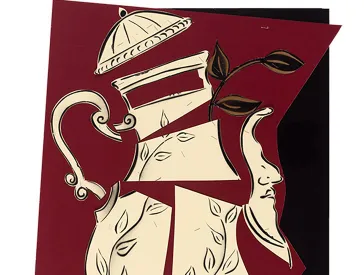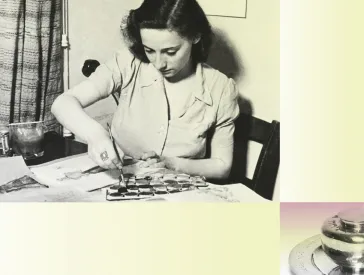Ton in Ton. Jüdische Keramikerinnen aus Deutschland nach 1933
Presseinformation
Pressemitteilung vom Do, 10. Okt 2013
Im Mittelpunkt der Ausstellung „Ton in Ton. Jüdische Keramikerinnen aus Deutschland nach 1933“ stehen vier Frauen, die in den 1920er-Jahren zur Avantgarde der deutschen Keramikkunst gehörten:
- Margarete Heymann-Loebenstein, in zweiter Ehe Marks (1899-1990)
- Hedwig Grossmann (1902-1998)
- Hanna Charag-Zuntz (1915-2007)
- Eva Samuel (1904-1989)
- Kontakt
-
Pressestelle
T +49 (0)30 259 93 419
presse@jmberlin.de
- Postadresse
Stiftung Jüdisches Museum Berlin
Lindenstraße 9–14
10969 Berlin
Im Rahmen des Berliner Themenjahrs „2013 – Zerstörte Vielfalt“ zeichnet das Jüdische Museum Berlin mit der Schau die künstlerische und berufliche Entwicklung der Frauen im Exil nach: Als jüdische Künstlerinnen war es ihnen mit dem Erstarken des Nationalsozialismus nicht mehr möglich, in Deutschland zu wirken. Zwischen 1932 und 1940 emigrierten sie nach Großbritannien und Palästina. Im Exil gelang den Künstlerinnen zwischen Aufbruchstimmung und Enttäuschung ein Neuanfang. Eine Auswahl von mehr als 60 Keramikarbeiten für den alltäglichen und rituellen Gebrauch zeigt, wie die Frauen in ihrem Ringen um ihre künstlerische Identität neue Ausdrucksformen im Keramikdesign entwickelten.
Michal Friedlander, Kuratorin der Ausstellung:
„Mehrere Jahre lang habe ich mich auf die Suche begeben, um anhand unterschiedlicher Informationsquellen die Geschichten dieser Frauen nachzuzeichnen. Die Ausstellung legt daher nicht allein den Fokus auf die künstlerische Qualität der Arbeiten, vielmehr haben die Stücke einen historischen Wert. Sie verdeutlichen die Lebenswege der Keramikerinnen, die in den 1920er-Jahren in Deutschland begannen“
Neuanfang in England
Die Kölnerin Margarete Heymann-Loebenstein, in zweiter Ehe Marks, gründete 1923 die erfolgreichen „Haël-Werkstätten für künstlerische Keramik“ in Velten, etwa 40 Kilometer nördlich von Berlin. Ihre Entwürfe zeichnen sich durch gewagte, moderne Formen, abstrakte Dekoration und leuchtende Glasuren aus. Nachdem die Nationalsozialisten Margarete Heymann-Loebenstein 1933 „staatsfeindliche Umtriebe“ vorgeworfen hatten, verkaufte sie ihre Keramikwerkstatt weit unter Wert an ein NSDAP-Mitglied. Neue künstlerische Leiterin wurde die junge Hedwig Bollhagen. 1935 erschien in einer antisemitischen Zeitung ein Artikel, der Entwürfe von Heymann-Loebenstein und Bollhagen verglich und die bei Haël hergestellten Formen als „entartet“ diffamierte. Eine der Teekannen, die den Artikel illustrieren, wird in der Ausstellung gezeigt. 1936 emigrierte Margarete Heymann-Loebenstein. Die Ausstellung folgt ihr nach England. Dort versuchte sie mit neuen Keramikprodukten unter dem Namen „Greta-Pottery“ wieder Fuß zu fassen. Jedoch konnte sie an ihren großen Erfolg in Deutschland nicht anknüpfen.
Neuanfang in Palästina
Die Berlinerin Hedwig Grossmann, die Hamburgerin Hanna Charag-Zuntz und Eva Samuel aus Essen gelten als Gründerinnen der modernen israelischen Keramikkunst. Sie kamen zwischen 1932 und 1940 nach Palästina. Ausgebildet in Deutschland, brachten sie hohe technische Fertigkeiten mit. Darüber hinaus verfügten sie über eine ausgeprägte künstlerische Sensibilität, starke Durchsetzungskraft und den Willen, sich den Herausforderungen eines Lebens im Nahen Osten zu stellen. Als Flüchtlinge und Pionierinnen entwickelten die drei Künstlerinnen neue Traditionen der Keramikkunst in Palästina und Israel.
Hedwig Grossmann zog nach Haifa und begann – auf der Suche nach Ton und anderen Rohstoffen – geologische Recherchen. Sie arbeitete ausschließlich mit Materialien aus der Umgebung und brannte ihre Stücke in einem selbst gebauten, holzbefeuerten Ofen. Dabei verzichtete die Künstlerin auf Ornamente und verwendete nur selten Glasuren. Angelehnt an nahöstliche Keramikformen und archäologische Fundstücke suchte sie nach einer neuen ortseigenen künstlerischen Sprache. Ihre entstandenen Arbeiten bestechen durch kraftvolle Silhouetten und makelloses Handwerk.
Hanna Charag-Zuntz begeisterte sich für das vergessene römische Töpferverfahren „Terra Sigillata“. Als Keramikerin von herausragendem technischen Geschick gelang es ihr, die Terra Sigillata-Technik neu zu beleben. Sie verarbeitete dünne Tonschichten und brannte die Objekte bei großer Hitze, wodurch sie ohne Glanzbrand oder Glasur schimmernde Oberflächen erzielte. Doch das genaue Geheimnis dieser Technik nahm sie mit ins Grab.
Eva Samuel fand in Palästina zunächst eine Anstellung in einer kleinen Jerusalemer Keramikmanufaktur. Dort wurde unter einfachsten Bedingungen gearbeitet. Die Künstlerin begann mit folkloristischen Figuren, angelehnt an die ethnischen Gruppen, die sie in Palästina antraf. Diese Figuren verkauften sich gut in Jerusalemer Kunsthandwerksgeschäften. Bald eröffnete sie zusammen mit Paula Ahronson eine eigene Werkstatt in Rischon Le-Zion. Trotz der hohen Kosten importierten sie Glasuren aus Deutschland. Um besseren Ton zu erwerben, nahmen sie streckenweise lange Wege mit dem Pferdekarren in Kauf. In der gemeinsamen Werkstatt fertigten sie Haushaltskeramik wie Kannen, Vasen und Schüsseln in traditionellen europäischen Formen. Bei der Bemalung orientierte sich Eva Samuel, die ihre Laufbahn als Malerin begann, an den Motiven aus ihrer neuen Umgebung.
| Ausstellungsdauer | 10. Oktober 2013 bis 9. Februar 2014 |
|---|---|
| Wo | Libeskindbau UG, Rafael Roth Learning Center |
| Eintritt | mit dem Museumsticket |
Eine Ausstellung im Rahmen des Berliner Themenjahres „Zerstörte Vielfalt“
Die Sonderwebsite mit Webfilm und weiteren Informationen zur Ausstellung finden Sie unter: www.jmberlin.de/ton-in-ton




